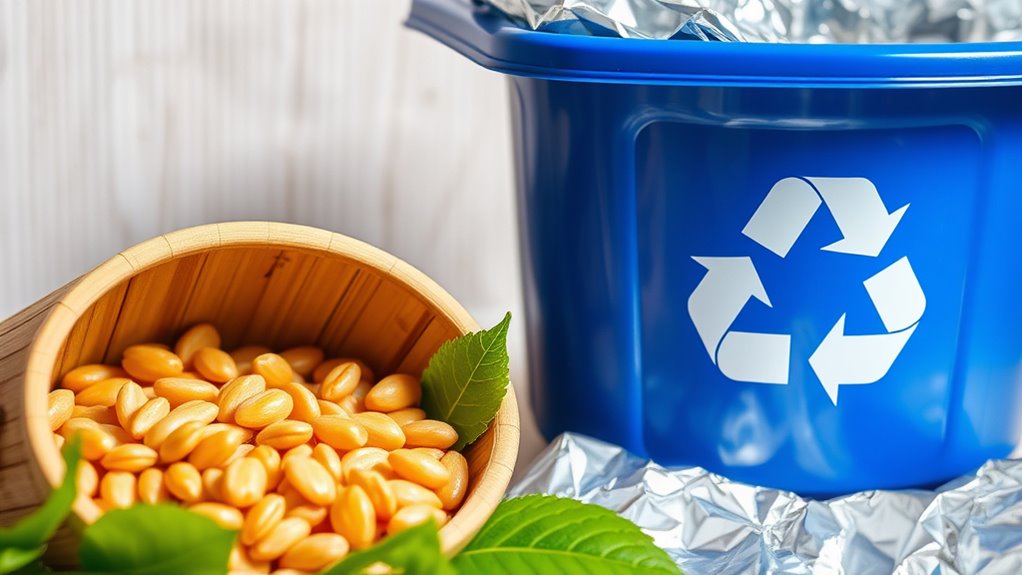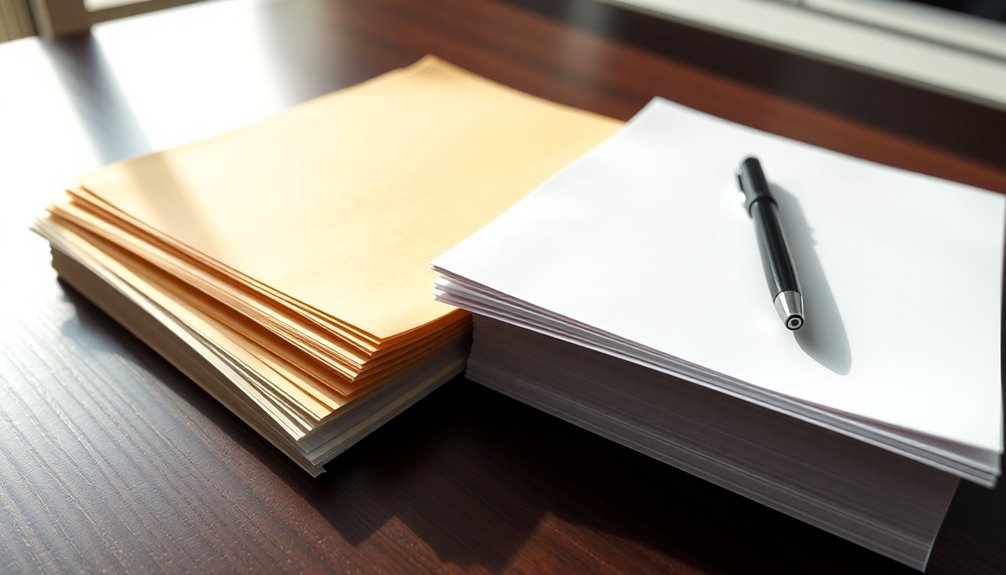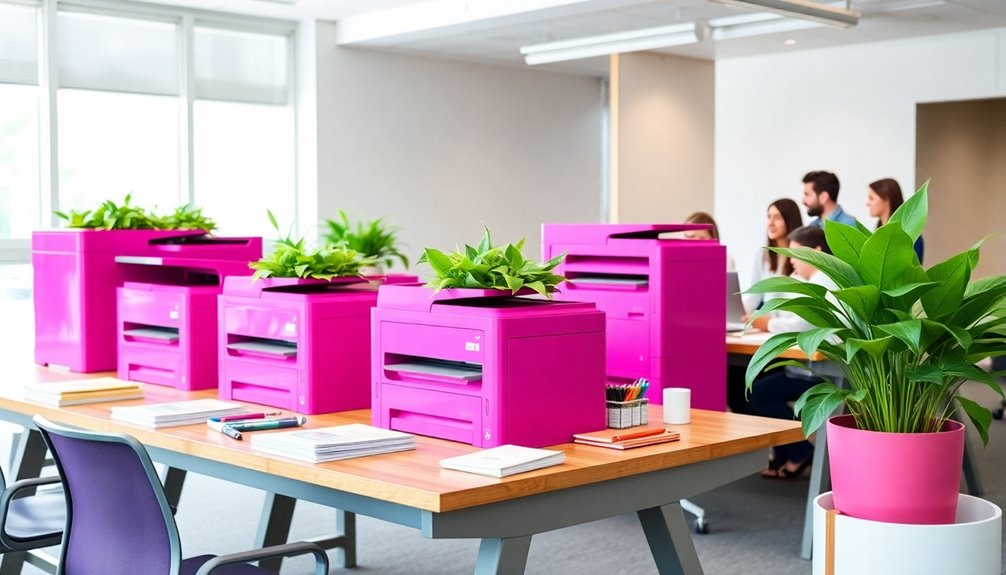When choosing between biodegradable and recyclable packaging, consider your environmental goals and disposal options. Biodegradable packaging breaks down naturally, but it often needs industrial composting facilities to decompose properly. Recyclable materials can be processed repeatedly, conserving resources, but require effective recycling systems. Your decision depends on local infrastructure and waste management practices. To make the most sustainable choice, understanding their benefits, limitations, and ideal disposal methods is essential—there’s more to explore if you want to get it right.
Key Takeaways
- Biodegradable packaging decomposes naturally under specific conditions, while recyclable packaging can be processed repeatedly into new products.
- Recyclable materials conserve resources and reduce waste through reuse, whereas biodegradable options break down more quickly in proper composting environments.
- Effective disposal of biodegradable packaging depends on industrial composting facilities; recycling requires efficient collection and sorting systems.
- Both options have environmental benefits but require appropriate infrastructure and management to maximize sustainability.
- Lifecycle considerations and local recycling or composting infrastructure influence the best choice between biodegradable and recyclable packaging.

When choosing packaging options, understanding the differences between biodegradable and recyclable materials is essential for making eco-friendly decisions. Your choices directly affect the environmental impact of your packaging, as well as the sustainability of manufacturing processes. Biodegradable packaging is designed to break down naturally through biological processes, often within a short period after disposal. These materials are typically made from plant-based sources, such as corn starch or sugarcane, which allows them to decompose without leaving harmful residues. This rapid breakdown can considerably reduce landfill waste and lessen pollution if managed correctly. However, the environmental impact of biodegradable packaging isn’t solely positive; it depends on proper disposal and the conditions under which it biodegrades. For example, some biodegradable plastics require industrial composting facilities with precise temperature and humidity levels to decompose fully, which may not always be accessible or practical for consumers. Additionally, the development of biodegradable packaging can sometimes involve the use of additives or chemicals that may have environmental implications if not carefully managed.
Recyclable packaging, on the other hand, involves materials that can be processed and remanufactured into new products multiple times. Common recyclable materials include paper, cardboard, glass, and certain plastics like PET and HDPE. Recycling helps conserve natural resources by reducing the need for virgin raw materials and minimizes energy consumption during manufacturing processes. It also decreases the volume of waste sent to landfills and reduces greenhouse gas emissions associated with producing new packaging. Yet, the environmental benefits of recyclable packaging depend heavily on effective collection and recycling systems. If recyclable materials are contaminated or not properly sorted, they often end up in landfills, negating their potential environmental advantages. Additionally, some recyclable plastics require energy-intensive processes, which can contribute to pollution and carbon emissions if not managed sustainably. Proper recycling infrastructure is crucial to maximize these benefits and ensure recyclable materials are diverted from landfills.
Both biodegradable and recyclable packaging have their roles in reducing environmental harm, but neither is a perfect solution on its own. Your decision should consider the entire lifecycle, including manufacturing processes, disposal options, and local recycling or composting infrastructure. While biodegradable packaging can be advantageous where industrial composting is available, recyclable materials are more practical when robust recycling systems are in place. Ultimately, understanding the environmental impact of each option helps you make informed choices that align with your sustainability goals. You can minimize ecological footprints by selecting packaging that fits your supply chain and disposal capabilities, ensuring your efforts contribute positively to environmental conservation.
Frequently Asked Questions
How Do Biodegradable and Recyclable Packaging Impact Supply Chain Logistics?
Biodegradable and recyclable packaging can improve your supply chain efficiency by reducing waste and disposal time. You might see lower logistics costs since eco-friendly materials often require less energy to transport and process. Additionally, adopting sustainable packaging can streamline your logistics operations, as it aligns with eco-conscious regulations and consumer preferences. Overall, these packaging types help you optimize your supply chain while supporting environmental responsibility.
What Are the Environmental Costs of Producing Biodegradable Versus Recyclable Materials?
You might find that producing biodegradable materials generally has a lower carbon footprint because they require less energy during manufacturing. However, they often need resource extraction like plant materials, which can impact land and water resources. Recyclable packaging usually involves more energy and resource extraction upfront but can be reused multiple times, reducing overall environmental costs. Balancing these factors helps you choose sustainable options for reducing environmental impact.
Can Biodegradable Packaging Be Recycled After It Decomposes?
Ironically, once biodegradable packaging has fully decomposed, it can’t be recycled again. The decomposition process breaks down the material into natural elements, making material reuse impossible. You might think it’s a closed-loop system, but it’s not. Instead, you’ll need to start fresh with new packaging. So, while it’s eco-friendly during use, don’t expect to recycle it after it’s broken down—its cycle ends with decomposition.
How Do Consumer Behaviors Influence the Effectiveness of Biodegradable Packaging?
Your consumer awareness and purchasing habits directly influence how effective biodegradable packaging is. When you choose eco-friendly products and dispose of them properly, you support sustainable practices. If you’re well-informed and prioritize biodegradable options, you encourage companies to produce more eco-conscious packaging. Conversely, neglecting proper disposal or ignoring product labels can reduce the environmental benefits. Your behaviors shape the success of biodegradable packaging in reducing waste and pollution.
Are There Any Health Risks Associated With Biodegradable or Recyclable Packaging Materials?
Sure, biodegradable and recyclable packaging might seem eco-friendly, but watch out for toxic chemicals lurking inside! You could face allergic reactions or ingest small amounts of harmful substances. While these materials aim to protect the planet, they might unintentionally expose you to health risks. Always check labels and opt for trusted brands—because fighting allergies and toxicity is a full-time job, even when going green.
Conclusion
Imagine your favorite snack wrapper as a tiny hero—either transforming into soil or becoming part of the recycling cycle. Choosing biodegradable or recyclable packaging is like giving it a meaningful mission: one helps it return to the earth naturally, the other keeps resources in circulation. With over 300 million tons of plastic produced annually, your decision can make a difference. By selecting eco-friendly options, you’re not just wrapping a product; you’re shaping a cleaner world.









